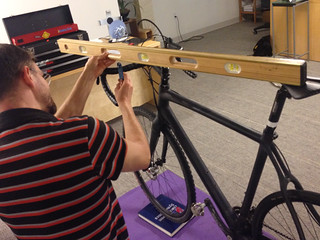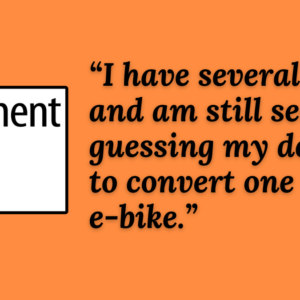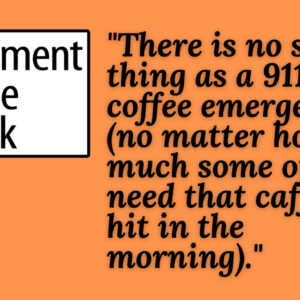Jonathan’s very personal post last week about recovering from his recent knee injury with the help of a local chiropractor prompted some useful and impressively respectful discussion about the lines between physical therapy, chiropractic care, training and health care in general.
But as a relatively casual rider who’s starting to feel the first persistent aches of my 30s, I was especially interested by a comment from a reader named David, who offered a simple, compelling introduction to the practice of bike fitting.
Advertisement
Bicycles have substantial bilateral symmetry. Humans, not so much; we just look that way.
Well fit, a bicycle [is] like a good pair of shoes, you don’t notice and go all day. Poorly fit, you notice.
If the fitter doesn’t squat down and watch you from all angles, at least from the four sides, go somewhere else. A good fitting takes more than one session.
Fitting has gone through three major approaches:
Anatomical, measurement, bio-geometric, formula measure lengths: the rider’s arm, leg, torso; do some math; adjust the bicycle. Epitomized by FitKit, important at the time. Improved by a goniometer to measure angles: knee, torso, arm. All static measurements. Few humans fit well any set of numbers.
Bio-mechanical, dynamic measure movement, usually with motion capture. Informed by sports-med. Improvement over bio-geometric. Still limited by an idea of correct position. Exemplified by Andy Pruitt. (Andy does good work but his book disappoints). This approach comes with a lot of technology and theater.
Neuromuscular adjust bicycle to rider’s current ability. Measure the rider’s range of motion off the bike, especially noting asymmetries of flexibility and strength. Adjust leg extension based on velocity of knee. Adjust handlebars based on strength and flexibility of back. Adjust torso position to improve cardiovascular performance. And many more details. Epitomised by Steve Hogg.
Good fitting starts at the feet.
Mindfulness makes the biggest difference. Every so often, for a few minutes out of every half-hour, pay attention to how you ride, how you feel, how you move, how the bike feels under you.
(Steve Hogg has a somewhat different analysis and goes into much greater detail, highly recommend you read him. )
Elsewhere in the same thread, reader daisy describes her own experience getting a fitting, which is available from nearly every local bike shop.
For all of us looking forward to many years of using biking to keep our bodies strong and limber, David makes a pretty good case that a bike fitting is worth considering.
Yes, we pay for good comments. We’ll be mailing a $5 bill to David in thanks for this great one. Watch your email!






Thanks for reading.
BikePortland has served this community with independent community journalism since 2005. We rely on subscriptions from readers like you to survive. Your financial support is vital in keeping this valuable resource alive and well.
Please subscribe today to strengthen and expand our work.
“For all of us looking forward to many years of using biking to keep our bodies strong and limber…”
Ok, here goes my know-it-all comment of the week…this here mindset is why most of us start getting serious aches and pains with riding around age 35-40. Biking is a lot of things, but especially if you ride a lot, and don’t do other things, for most of us, it will definitely not keep you strong and limber. It will keep some of your muscles strong and some of them limber, but unless you’re a genetic freak, it will not keep you strong and limber. A good rule of thumb from the great Steve Hogg is that for every 2 hours you ride you need to spend an hour working on your functional fitness: core strengthening, stretching, yoga, etc, etc, etc. And that’s the truth Ruth!
I second that opinion – Becoming a “cyclist” caused me to also become a runner to balance out my leg muscles and keep my knee cap better aligned. The more I bike the more I need to run, skate, swim and stretch to keep from overdeveloping certain muscles. The up side is more exercise!! Humans are complicated.
Thanks, man!
I’m glad you rewarded this comment as these are excellent observations. My best friend developed a knee problem when he took up cycling so I recommended a bike fit. He tried a number of stop-gap solutions that more experienced friends recommended, but ultimately we took up a collection for his birthday to get him a fitting because we knew he was too cheap to pay for it himself. They figured out pretty quickly that his right leg was slightly longer than his left, and with a simple shim to his cleat and some tweaks in seat height and cockpit length he’s been trouble-free ever since.
Myself, I pronate with my right foot, and I thought at first it was a variation in leg length but it just seems to be the way I was built. David’s comment is very astute and informative and deserving of recognition.
If they figured out pretty quickly that your friend has a leg length discrepancy the fitter might have been overextending their expertize. It is more common for a person to have twists in their hips. It would take an x-ray and a reading by a radiologist to truly determine if a discrepancy was the cause.
Yes, only a standing pelvic x-ray and a reading by a master radiologist diagnoses leg asymmetry. And even then it’s tricky.
We can observe functional asymmetry in standing, walking, and pedaling, and if needed compensate.
Leg differences less than 6mm rarely cause problems or need anything to compensate. The rider has usually had the difference for a while, since birth or since injury, and has adapted.
When I switched to Touring Bikes (different profiles) …carried an allen set with me for about 2 months. Read up on everything about fitment that was available. Small tweeks on many rides. Stop & adjust on side of road.
Getting the saddle height & angle , the bars height , reach and attack took quite some time to get it right. It WAS worth it.
Am amazed at the number of riders on expensive bikes , wearing all the costly gear ..pass me with hips badly rocking side to side …(too far a reach for pedals, wasted energy. ie: saddle too high)
As a 53 year old rider who has some major injury issues (Double Miniscus Tear on my left knee) A good bike fit with a trained Physical Therapist isn’t just a good idea it’s necessary to keep me riding.
I also try to balance the amount of Bike Riding I do by engaging in Water Aerobics, Yoga, Walking, and regular Massage and Acupuncture sessions to keep my self limber.
Big thank you David, I didn’t know most of these terms but this was a very useful comment.
Also, look into recumbents. It’s just a more ergonomic design.
In 1896 Archibald Sharp explained that speed of knee is proportional to force on pedal, so it IS important to know that speed.
Sharp also showed that this proportionality can be derived solely from the geometry of rider sitting on saddle. Four lengths are involved:
Hip joint to knee joint;
Knee joint to pedal spindle;
Length of crank;
Bottom bracket spindle to hip joint.
These comprise what a mechanical engineer calls a “four-bar-linkage,” from which one constructs, from pure geometry, a “hodograph.” For a rider on a standard bicycle the hodograph looks like an odd and tilted figure eight, which has an extremely valuable property, namely, that the AREA bounded by the lower lobe of the figure eight is proportional to the the TORQUE developed by the rider on the machine.
No fancy instrumentation and dynamic measurement is necessary to determine this–just the geometric properties of the four-bar linkage composed of rider and bicycle!
Strictly, this analysis applies only to fixed-gear drivetrains, the only kind known in 1896. With modern dynamical measurements one can prove that fitting a free-wheel drivetrain DECREASES torque at any speed by about 25%!
Guess why fixies at Mount Tabor climb like rockets, generating essentially the same lap-times as road bikes. Recovery at Tabor is minimal, and with fixies, non-existent. Fixies do four laps and are done.
I earnestly wish that cycling gurus of all types would learn these basic facts, which are the first step in “fitting” rider to machine. Without such knowledge further analysis can be only educated guesswork..
Wow. Thanks!
I wish I’d written that better.
Sharp wrote a great book and Dover sells a nice reprint of _Bicycles & Tricycles_ and you can also download it .
But humans aren’t machines of bars and linkages. Muscles, and tendons, and ligaments, and the brain come into play.
My sloppy writing, sorry:
We look for a *change* in the velocity of the knee to know if the rider overextends the leg. Though I can neither see nor measure the tendons, and ligaments, and brain, I can see the result, for that rider, and for that leg. And make adjustments.
I remember the fun I had going up Tabor on my single speed.
archive.org/details/bicyclestricycl02shargoog
For anyone who puts some serious miles on a bike, particular a road bike, I can’t deny that getting a fitting done by a qualified professional is worth its weight in gold.
For those of us who rarely ride more than 5-10 miles at a time, and decide not to invest in a bike fitting, I have two tricks that seem to work for getting a good fit:
1. (This is a common tip for setting the seat height). While coasting, place both of your *heels* flat on the pedals and pedal backwards. Your knee should be nearly fully extended when the crank is in line with the seat tube. Then pedal normally with the balls of your feet on the pedals. There should be a slight bend in the knees and your hips should not rock back and forth.
2. While pedaling with no hands, place your hands one millimeter above the handlebars. You can even wrap your thumbs around the bottom of the handlebars, but don’t put any weight on the handlebars. You should feel comfortable riding in this position with no hands. If you’re feeling the urge to grab the handlebars to support your weight, then something needs to be adjusted. A few options are: a) the nose of your seat may be pointed down too much, b) the handlebars may need to be adjusted vertically and/or longitudinally, c) the frame of the bike may be the wrong size for you.
I’ve tried this “no hands” fitting technique on a few different bikes including a fairly upright commuter, a folding bike (not quite as upright), and a road bike. This fitting technique worked great for the commuter and folder.
I can’t say for sure if it applies to road bikes because the road bike I tried it on didn’t fit me right. I suspect it will hold true as putting weight on one’s hands is bad for the wrists and neck. It can also be the source of back problems.
I’d be curious to hear if anyone with a perfectly fitting road bike could try the “no hands” technique and report back.
The “no hands” test is a good one, and applies even to a drop bar road bike with substantial saddle to bar drop.
Too much weight on your hands is a common complaint for riders on road bikes.
One change to try is to make the saddle level, or even very slightly nose up. A nose-down saddle causes you to slide forward, which means you push back on the bars.
Another change is to move the saddle rearward. That pushes your butt to the rear, which balances your torso which is forward. Thus balanced, you are not tipping forward and thus don’t need to support yourself on your arms. (Imagine standing up then leaning your torso forward; if you don’t move your butt rearward, you will fall forward; try this with your heels and butt pressed against a wall, and you’ll see.)
If those don’t work, you may need a shorter stem, smaller bike, etc. Or you may simply need more core strength.
Please realize that there are fitters–at least one or two–in Portland with great skill and years of experience but there are others that regardless of their high-tech equipment and paper credentials are beginners and/or amateurs with little real-world experience. Make sure you’re not some newby’s “learning experience.”
Agreed. I paid for a licensed Physical Therapist from the http://www.bikefit.com style to fit me, and I ended up with far more complicating pains than I started. Ended up pulling off the cleat shims on the side of a trail, and I gradually undid the rest of the recommended changes. Took a couple months for ankle tendons to heal. The obsessive focus on perfectly symmetrical foot and knee alignment really did not work for me. In the end, I got the feeling that my fitter might’ve had more theory than experience.
This is all a little silly to me.
Casual riders and new riders working up the courage to get on the street don’t need this obstacle to worry about.
Unless you are putting lots and lots of miles in each week, I think the local bike shop is a fine place to get fitting advice.
For many new rides you’re very likely right, but I’d contend that the work of real, professional bike fitters has upped the game of many stores.
Test. Comment awaiting moderation.